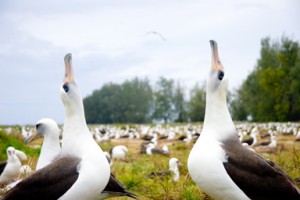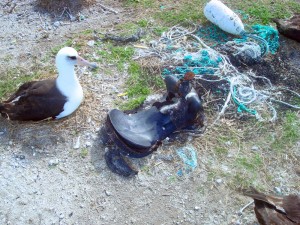I stepped into the pages of Rolling Stone today. No rock-and-roll but plenty of plastic.

When Rolling Stone magazine ran an article this past October titled “The Great Pacific Garbage Patch,” I received exactly two text messages and three emails. Family and friends thought I might know something about this plastic vortex. Is this true? Is it really the size of Texas? Can you see it from space? I had read a few journal articles about the presence of micro plastics in the stomachs of seabirds. Besides from that, the topic was as obscure to me as metaphysics. I had never seen this so-called “patch.”
The patch is actually not easily visible, like an oil slick or the Great Wall of China might be. The problem of ocean plastics reveals itself in much more discreet and destructive ways: ingestion by marine mammals, coral reef entanglement, or beach litter. (NOAA has a great myth-buster website about the “garbage patch”). Where I sit now in Midway’s old navy barracks, I am a few hundred miles south of the hyped “patch.” Still, the gravity of the plastic problem revealed itself today during our marine debris beach survey.
Comprised of ten beachcombers and ten bloated bags of plastic, our group was suddenly approached by a critically endangered Hawaiian monk seal (only 1,100 individuals left in the wild). The yearling hauled out from the white water about 20 yards from us. At once, we were experiencing the majesty of the ocean and its abuse. The contrast was truly striking.
Indeed, the media often misinforms us about the effects of marine debris on survivorship of marine animals.Rolling Stone claims that 100,00 marine mammals die each year from plastic debris. Our trip leader and marine mammal scientist Dr. Andy Read argues that this mortality effect is inconclusive. Plastics are certainly a growing problem in the North Pacific – the media has made that known – but its definitive sources and end effects on ocean residents are less certain.
Midway Atoll is trying to quantify this problem. A current island study shows that 23% of the marine debris that the tide brings in has a land origin, 18% has a fisheries origin, and the remainder is unknown, mostly unidentifiable shards of plastic. Midway Atoll Nation Wildlife Refuge deputy site manager John Klavitter crunched some statistics on the atoll’s yearly atoll accumulation.
– 8 tons of plastic debris washes up on the beaches of Midway Atoll
– 8.6 tons of netting from fisheries becomes entangled on reefs or sand
– 4.5 tons of plastic are brought in by seabirds and fed to their chicks
Plastic is present but how does it affect the islands ecological balance? There is no conclusive evidence that albatross chicks are dying directly from plastic ingestion; its most likely that plastic ingestion contributes to other natural forces – like dehydration and starvation – to decrease chick fitness and cause higher mortality rates. Given that 99.9% of Midway’s albatross chicks having plastic in their gut, scientists hypothesize that this phenomenon could likely impact population size in the future.
Since the resident Black-footed Albatross and Laysan Albatross forage on different species in different ranges of the North Pacific, it’s also hypothesized that the two species bring in different amounts of plastic. Perhaps the current species composition of the island’s seabird population may shift due to variable plastic forces, suggests Klavitter.
Rolling Stone provided the “shock,” but what the media doesn’t make clear is that we need still to clarify the “awe” – and extent – of this problem. At Midway, at least, they are beginning to scratch the plastic surface.
**************************

There were some precious treasure in the approximately one ton or marine debris we collected from the beach today. Everybody had a favorite:
Andy: a fresh water lure
Matt Potti: lighter with Japanese characters
Rhianna: a riding saddle
Josh: an intact construction helmet
Nick: 8-foot corrugated sewer pipe
Dave: car Reflector
Matt Bowers: plastic O-ring from Denmark
Amy Smith: computer monitor
Tom: wiffle ball
Katelin: milk bottle half-full with milk
Clare: star of David holiday decoration

Altered ecosystems in the Pacific, the Atlantic, and all oceans,should provide the focus for scientists to discover and teach safe recycling/ chemical alteration of all man made materials; you make it, you report how to safely break it down. The time for streamlining and strengthening international and national policies and laws around earth’s fragile ocean resources is incredibly past due. Enjoying following all students’ powerful discoveries.
Where did you find the saddle? We spotted one on Eastern Island last year – I wonder if its the same one?
Hope you guys are enjoying every minute of Midway, I wish I could go back!
Jen